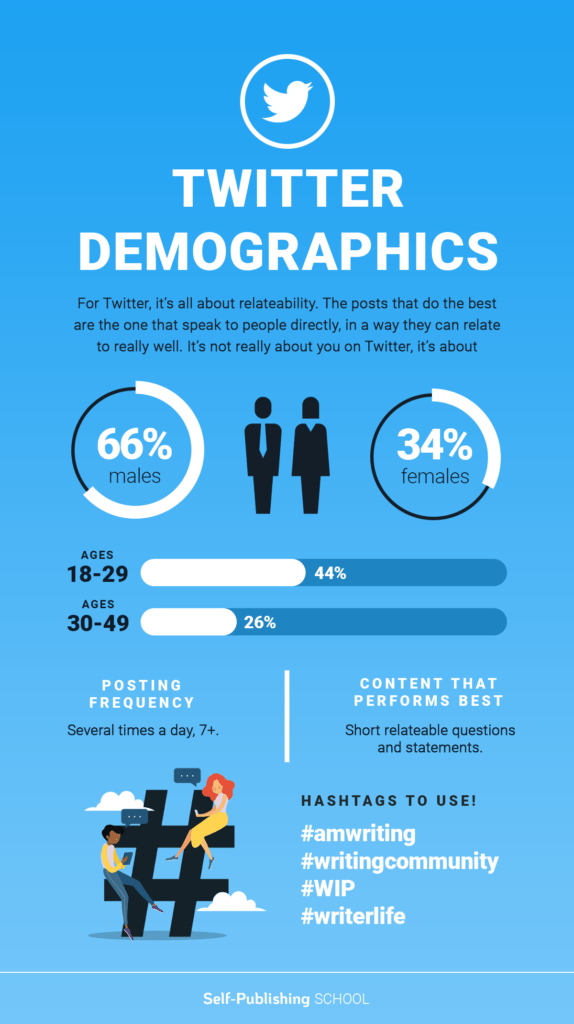Whether you’re self-publishing or traditionally publishing, writers are responsible for building their own author platform to market their writing. One of the most accessible, cheapest, and easiest ways to build an author platform is through social media. And one of the most popular social media platforms for authors to use is Twitter.
Should you be on Twitter? (Yes.) How should you use Twitter? How do you get followers, what should you post, and how often? We’re going to answer all of those questions and more for you today.
This guide to Twitter for authors covers:
- Why should authors tweet?
- What should authors tweet?
- How do authors get Twitter followers?
- Best Twitter hashtags for authors
- Twitter tips for authors
Why should authors tweet?
Twitter is where a lot of conversations happen, between authors, agents, readers, and publishers. If you’re a writer, especially an indie writer, Twitter is one of the spaces you should get comfortable in.
Here are five great reasons why:
- It’s a free way to start building your author platform! Later on, you might want to invest in different promotional methods for your platform and your books, but Twitter is free to use, super easy to start and maintain, and is a great place to begin.
- To connect with other writers. Twitter is great for meeting other writers in your genre and around the same place in their writing journey as you! You can also meet writers who are further along in their careers to learn from.
- To connect with readers. Readers love to connect with their favorite authors and new writers through Twitter–you can add to your reader base, interact with your audience, and learn more about what your demographic is interested in reading.
- To connect with potential publishers. If you’re traditionally publishing, Twitter is a way to meet agents and publishers. Agents often scout through social media, and it’s just an easy way to make contacts. You can reach out to them with specific hashtags, which we’ll talk about later. Even if you aren’t traditionally publishing, following publishers is a way to keep up with what everyone else is doing, and to know what the market is looking for.
- To learn about the industry. Following writers, agents, readers, and publishing companies will give you insights into best practices, your market, trends, and demand for different types of writing.

What should authors tweet?
So you’re on board that you should have a Twitter–now what do you put on it? Here are some examples of different content you can use to promote yourself and your books while naturally engaging in conversations with your audience.
#1 – Promotional posts
Share things like release dates, WIP updates, discounts, and blog posts to keep your followers informed about what you’re up to.
You want to space out your promotional or “business” posts with at least three other posts between them. Keep reading this list for ideas of what your other posts can be.
#2 – Personal content
If your Twitter is all business and self-promotion, you won’t get too many followers.
What can you offer outside of that?
Humor, advice, interaction? Maybe you’re a parent and you post content for parents, or pet pictures for other animal lovers. Find your niche and make sure you’re posting interesting content other than self-promotion.
#3 – Excerpts
Many authors post excerpts from their current WIP to garner interest in it before publication.
Here’s an example from my Twitter:
#4 – Writing games
You can make up your own games or play ones that have already been made as a way to interact with readers and writers. In this tweet, Owen’s introducing a month-long game for writers to build their world.
Self-Publishing School actually offers a course that had an entire section dedicated to Twitter writing games to grow your platform.
Here’s an example of what this looks like:
#5 – Questions
Asking your audience questions is a great way to boost interaction. You can use questions, polls, and other interactive posts to get engagement from your audience.
Here’s Bella, our Content Creation Specialist, using this method.
She gives an update on her writing process, mentions her WIP, and asks a question for her followers to answer all in one tweet.
#6 – Aesthetic boards
Most writers love making aesthetic boards. It gives you a feel for what your characters look like, pulls in your book’s imagery, and can make an attractive post to go with prose excerpts or just on its own.
It’s another way to promote discussion and build some hype for your upcoming book.
This writer made an aesthetic board specific to one of their characters:
Notice how all of these examples make good use of hashtags? Keep reading to learn which ones you should use!
How do authors get Twitter followers?
So we know we need a Twitter, and we know what kind of content to post–now how do we get followers?
Here are four tips to help you get started, and to help keep your Twitter active and engaging.
- Make sure you post good content! Anyone can buy followers or use the follow-for-follow method, but if you’re consistently posting good content, you will attract followers who are active and will engage with your posts (and eventually buy your books). An active audience is a profitable audience. Using cheap methods to gain followers will give you inactive accounts and bots. The numbers might be satisfying for the short-term, but it won’t do you any good in the long run.
- Interact with people! Like, retweet, and comment on other writers’ tweets. But don’t just spam for attention. Look for content you genuinely enjoy, and interact with it. Tip: Asking questions is a great way to foster conversation.
- Don’t forget to link your Twitter handle on your website, in your newsletter, in your blog posts, and on other social media platforms to drive traffic to it. You can even link it in your email signature!
- Tweet consistently. Engagement posts, promotional posts, and sharing other people’s content should be enough for you to keep a consistent stream of content to attract new followers. If you ever get stuck, come back to the list we made about types of content for authors to tweet!
I promised we’d talk about hashtags, so let’s talk about hashtags!
Best Twitter hashtags for authors
Hashtags are how tweets are categorized. If someone is interested in a certain topic, they can browse tweets that have used that hashtag–so use appropriate and relevant hashtags to get new followers!
The Social Media For Authors course actually covers the BEST hashtags for (fiction) authors to use, along with how to find the BEST hashtags if you write nonfiction books.
Tag your tweets with one or two of these, and you’ll see a jump in interaction. Social media experts recommend no more than three hashtags, because any more than that discourages people from retweeting.
One of the most popular hashtags for author twitter is #AmWriting.
This is for any tweet about, duh, writing. You can use #AmWriting for WIP updates, writer observations, excerpts, and anything related to your work in progress.
There are also a ton of sub-hashtags in this one, like hashtags specific to your genre:
- #AmWritingFantasy
- #AmWritingRomance
- #AmWritingMystery
- #AmWritingFiction
- #AmWritingPoetry
- #AmWritingCoverLetters
Other branches of this hashtag are for different stages in the writing process, like:
- #AmEditing
- #AmOutlining
- #AmQuerying
- #AmRevising
When you’re first starting out in a new social media space, it’s great to find people who are doing the exact same thing you are.
Use hashtags to connect with other writers! Here are some popular examples:
- #WritersLife
- #WritingCommunity
- #WritersCommunity
- #ReadingCommunity
- #Writers
- #Authors
- #IndieAuthors
- #PoetryCommunity
There are hashtags for producing story and non-story writing content.
Use these to tag your discussions about writing advice, future plans, to do lists, word count goals, and things related to writing:
- #WritingTips
- #WriteGoal
- #WriteMotivation
- #WritingPrompt
- #WIPAesthetic
- #WIP
- #WorkInProgress
There are even hashtags for different days of the week!
If you’re struggling for content to tweet, check out trending hashtags, or day-specific ones like these:
- #MondayMotivation
- #TuesdayThoughts
- #TeaserTues
- #WriterWednesday
- #WedWIPAesthetic
- #FollowFriday
- #FridayReads
And honestly, there’s nothing stopping you from making up your own!
Here are some hashtags you can use for the writing industry:
- #AskAgent (use this tag to get answers to your questions from writing agents)
- #AskAuthor (use this tag to get answers to your writing questions from, duh, authors
- #AskEditor (you get it)
- #PitchWars (the hashtag for the mentoring program where published authors/editors help a writer with the manuscript and the query process)
- #PitMad (a pitch party on Twitter where writers pitch their manuscripts for agents and editors)
- #MSWL (Manuscript Wish List, which agents use to describe what sort of things they’re in the market for)
- #SelfPub
- #SelfPublishing
Aside from tagging your tweets with these hashtags, browse them to find new people to follow and interact with!
Twitter tips for authors
Now here are some general tips to help you get the most out of your Twitter account:
- Spend time on your profile photo, cover image, and bio! Compose a cohesive and attractive brand through those elements. This will help to build a consistent brand, help people find you (especially if it’s consistent across all of your social media platforms), and make you a more recognizable and respectable presence.
- Interact with other writers to make connections and build your platform. Especially early on, new writers are all looking to make friends with other writers, so they’re a great way to start building a network.
- Watch what you say! Even if you delete a tweet, it never goes away. People are quick to screenshot, and there are lots of programs to retrieve deleted content. Make sure you think through anything you post online, make sure you’re being respectful, and make sure you’re saying things that you stand by.
- The mute button is great! Use it! The block button is better! Use it more! It’s easy to get sucked into arguments or to get upset by other people. There’s nothing wrong with cutting out meaningless negativity, or even just people who particularly annoy you. I went a long time without muting or blocking anyone, and as soon as I started doing it, I enjoyed Twitter a lot more. Twitter is a tool, so use it in a way that is beneficial to you.
- Experiment with different kinds of content to see what you like, and to see what your audience is interested in. When you’re figuring out your brand and platforms, it’s good to use that time early on to try out different things and see what works best!
- Attach images! Tweets with images perform way better. Check out Canva for Twitter for some easy-to-create templates.
That’s the why, where, what, and how of Twitter for authors! Have fun, be courteous, and use it as a learning experience.
